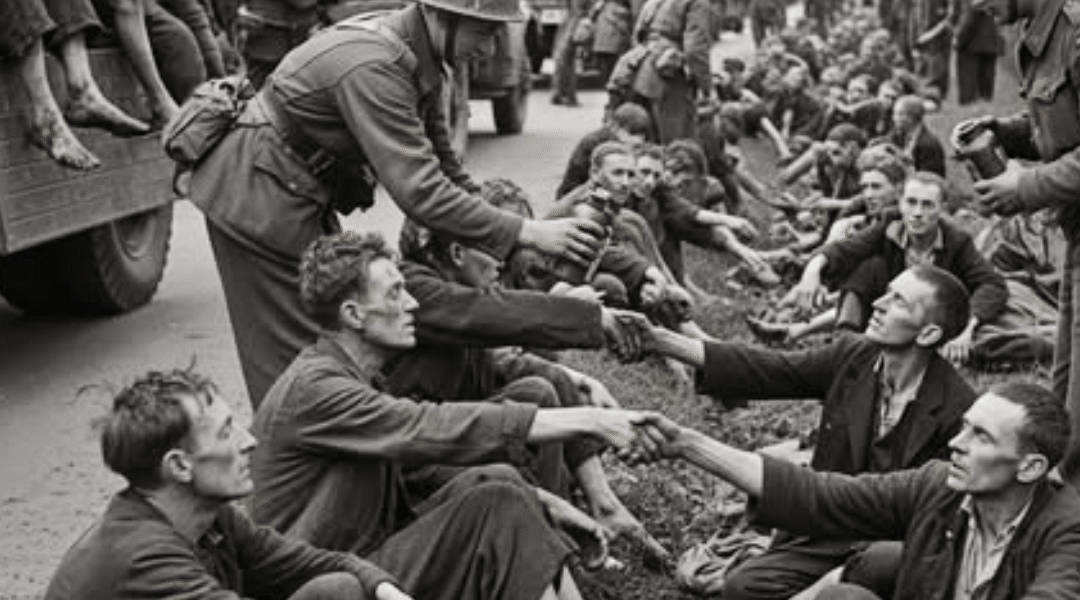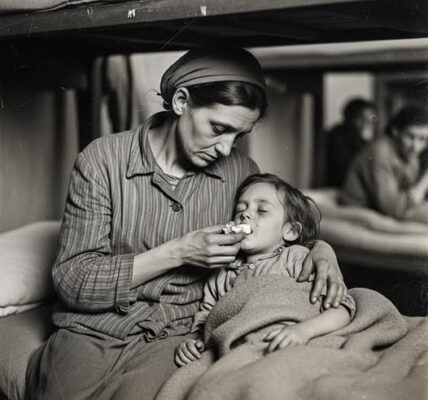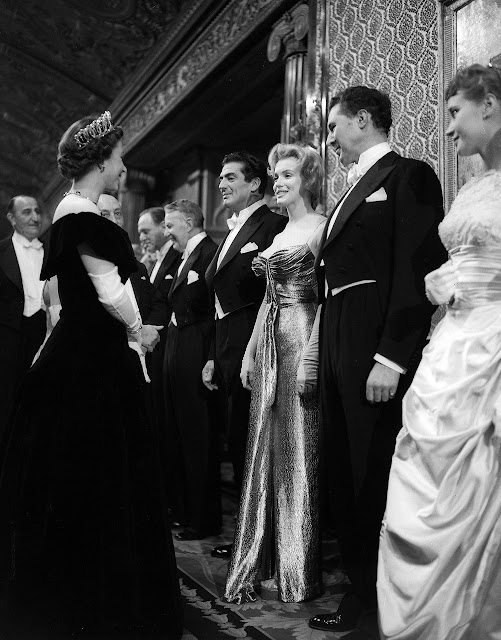Survivors of the Neuengamme Death March – Northern Germany, May 1945

In May 1945, at the end of a bloody world war, the roads of northern Germany became the scene of a human drama of unspeakable intensity. As the British Army advanced, liberating villages and plains, they encountered scenes no soldier, even the most experienced, could have prepared for: starving figures, bodies lying in ditches, faces sunken from hunger and exhaustion. These were survivors of the death marches from Neuengamme concentration camp, a camp near Hamburg that had become synonymous with horror and human destruction.
These men and women were mere shadows of their former selves. For weeks, they had been forced to march, forced by SS guards to leave Neuengamme and its numerous subcamps to escape the Allied advance. The Nazis hoped to erase the traces of their crimes, to scatter the prisoners like sand before the wind, even if it meant condemning them to a slow agony. Those who collapsed by the side of the road were mercilessly shot or left for dead. Every step became torture, every breath a struggle against the inevitable.
As British trucks drove along these tree-lined roads, soldiers saw survivors lying on the ground, sometimes grouped in small circles, sometimes isolated like human wreckage washed up by an invisible wave. Liberators climbed from their vehicles, holding bottles of water, breaking pieces of bread, and muttering words of encouragement. A gesture as simple as placing a hand on a shoulder took on its full symbolic value: restoring to a broken being the certainty that it still existed.
Many survivors no longer had the strength to speak. Their chapped lips pressed against the cold metal of the water canisters they were offered. Others, trembling, tried to smile, as if their faces, long paralyzed by fear, were slowly rediscovering the art of human emotion. A British soldier wrote in his notebook: “I have never seen such thin men. They looked like ghosts, but when we gave them water, their eyes lit up in a way I will never forget.”
The liberation of the Neuengamme survivors did not occur at the camp gates, but on these rural roads, in the heart of a peaceful landscape that contrasted cruelly with the scale of the suffering. Blossoming trees, green meadows—all this created an almost idyllic setting, indecent in the face of human suffering. And yet, it was precisely in this contrast that the power of the moment lay: life was revived where it had been taken.
Neuengamme, established in 1938, was one of the most powerful concentration camps in the Nazi system. More than 100,000 prisoners passed through it, exploited for slave labor in inhumane conditions, almost half of whom perished. As Germany’s defeat became inevitable, the SS organized mass evacuations. These forced marches—later called death marches —were intended to remove deportees from the combat zone, but above all, they were intended to serve a slow extermination.
Survivors encountered in May 1945 had walked dozens, sometimes hundreds, of kilometers, barefoot and dressed in rags. The luckiest still had a blanket or a piece of dry bread. The rest clung to their desperate will to avoid falling. A man liberated near Lübeck recalled: “We were no longer walking; we were falling forward, over and over again. When someone fell, the SS left them or killed them. I survived because a comrade carried me when I could go no further.”
For the British soldiers, this shocking discovery had a twofold significance. On the one hand, it confirmed what reports had already suggested: the horrors of the concentration camps were beyond imagination. On the other, it placed a tremendous responsibility on them: they had to rescue, care for, and rehabilitate survivors, even though the war was not officially over. Military medics set up makeshift aid stations along the roads, distributing milk, soup, and blankets. Yet, despite all efforts, many still died in the arms of their liberators, overwhelmed by mounting hunger, disease, and exhaustion.
Yet, amidst this tragedy, moments of light emerged. One British soldier recounted seeing two prisoners silently clasping hands, their trembling fingers intertwined as if sealing a promise of life. Another described how a woman, barely able to stand, began to cry when a child from a neighboring village offered her an apple. These simple, almost innocent gestures took on an infinite dimension: they affirmed human dignity in the face of abyss.

Through their resistance and courage, the survivors of Neuengamme unwittingly became crucial witnesses to history. Their stories later influenced the Nuremberg trials, revealing to the world the mechanisms of Nazi cruelty. However, in May 1945, on the roadsides of northern Germany, they were not yet witnesses: they were simply beings to be saved, lives in limbo that had to be preserved at all costs.
Every sip of water, every shared piece of bread, every arm that lifted a survivor from the ground was a fragile victory over barbarity. Freedom didn’t come in a single, brilliant moment, but in fragments: a blanket thrown over bare shoulders, the offer of a cigarette, the shake of a hand. And these fragments carried an enormous burden. They were proof that, in the face of the unthinkable, survival was still possible.
Seventy or eighty years later, images of these death marches still haunt our collective memory. They remind us that the Holocaust was not limited to barbed wire and watchtowers, but left its mark on the roads, villages, and forests of Europe. They also remind us that liberation was not merely military, but profoundly human.
In the spring of 1945, defeated Germany still bore the scars of war, but amidst the ruins, a certainty emerged: humanity had survived. Not untouched, not unscathed, but alive. And it was in the eyes of the Neuengamme survivors, in their hands reaching out to the hands of British soldiers, that this truth first became embodied.




